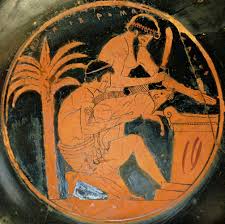By Thomas Parker (Regular Contributor)
Do you feel real resentment when somebody takes a bite of your sandwich and surgically removes the meat? Or are you the meat remover? Why is it bad form to eat cheese without bread in France? Is it just a question of taste or is more at stake?
If Plato and the Ancient Greeks were to chime in, they would make these ethical questions. We distinguish simply between the categories of “food” and “drink,” but the Ancient Greeks had three categories: sitos, opson, and oinos. The first, sitos, was the staple. It was usually bread made from wheat, but sitos could consist of barley or other grains, beans, or pulses. The second, opson, was the relish. It was typically meat, fish, or cheese, but it could be anything that flavored the sitos. The third, oinos, was wine.
Meat was the most prestigious opson, but was relatively rare in antiquity. Meat eating was special. It was highly ritualized, and always preceded by sacrificing a part of the animal to the gods. In general, meat was consumed more by the wealthy, and thought most fitting for heroes, warriors, and athletes, establishing food-based class and gender hierarchies early on.
Conversely, eating meat was also the sign of the barbarian. He shared with the hero a prodigious consumption, but was imagined showing his savagery by eating meat like an animal, usually raw with reckless abandon. Fish, though not a ceremonial food, became the opson most associated with conspicuous consumption, enjoyed by wealthy gourmets and gourmands.
Yet, sitos-based society was not as virtuous and democratic as it might sound- at least not by our modern standards. The ancients possessed a grain hierarchy that placed wheat on the top. Gluten was one key to wheat’s prestige. It provided structure and facilitated the wondrous form and fluffy texture. Barley did not have the leavening power of wheat, and was more flat.
The texture and color counted too. More highly processed white bread—the lighter, the better— was generally held in higher esteem than coarser dark breads, mashes or porridges. The Roman physician Galen categorized black breads as “dirty,” noting that they were typically consumed by the poor.
Sitos set itself apart from opson in other ways. Ovens and mills were necessary for bread. Fields had to be plowed and tended, and bread required an elaborate infrastructure premised on set methods and stability. So much was this the case that the “milled life” came to mean “civilized order” in Greek.
But that “civilized order” was also labor intensive. So much so that it subordinated women and slaves to complete the disproportionate amount of work it brought with it. Indeed, women’s identities became so rooted in cereal production that ancient marriage ritual reinforced the role of women as the processors of grain (Wilkins and Hill, 2006, 118). Though agriculturalists pointedly derided the less advanced pastoralists, hunters, and fisherman who lived more on opson, sitos ultimately encouraged inequity and the need for forced labor in ways primitive opson eaters did not.




